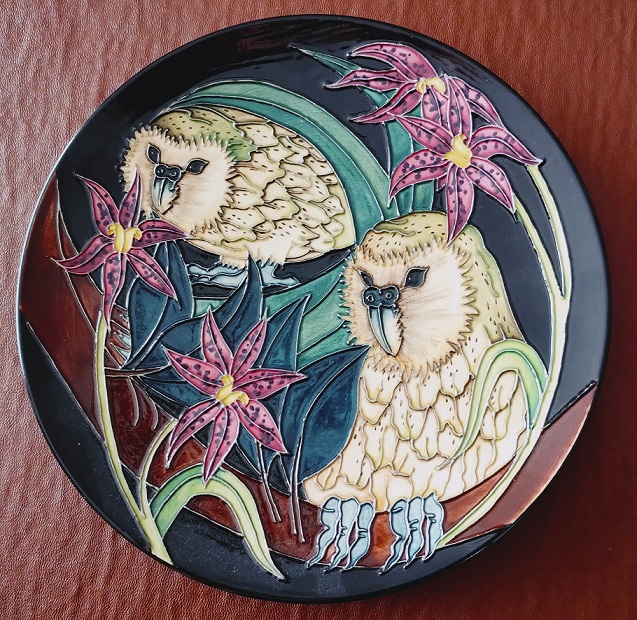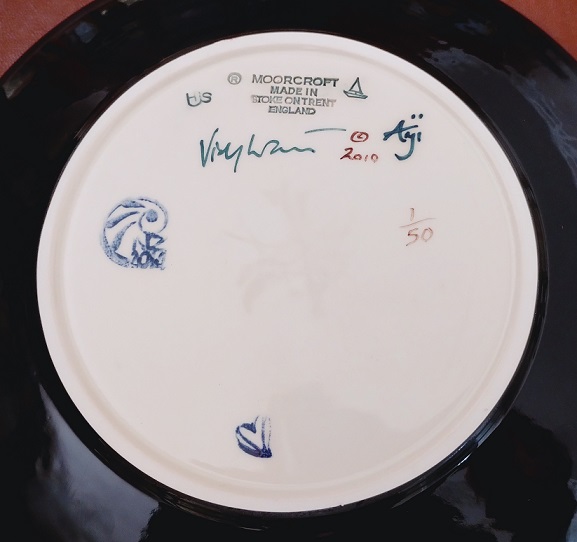
In recent years Moorcroft have applied their designs to objects beyond the traditional vases and handled jugs that they are renowned for. I don’t think is just because their showpiece vases are, necessarily, expensive but the diversity also provides a wider range of items to potential customers. Being a high-end, high-price producer of art ceramics almost killed Moorcroft once and it’s been the death of several others so diversification has helped them to survive and thrive.
The smallest item that designs appear on are pin dishes which sell for relatively modest amounts and at auction tend to be sold in groups to make a meaningful lot. These are not poorer quality than the larger pieces, they’re just smaller and that’s the key to their appeal. The diversification isn’t just about smaller items though. Larger items such as clocks, plates and wall plaques sell for every bit as much as similarly sized vases, but they provide flatter surfaces which lend themselves to a more picture-like canvas and have the benefit of allowing the owner to see the whole design at once.
One such item in our collection is a plate depicting two Kakapos. This is the only piece of first quality Moorcroft that we have bought new, thus paying full price. It was something of an impulse purchase but one with a rather long story behind it…
For a couple of years I worked with a brilliant Norwegian software developer called Håvard. Håvard was a quiet, quite reserved guy who announced one day he was going to New Zealand because he wanted to do a Bungee Jump, his first, off the bridge where all started. Of all the people I knew at the time, I reckon Håvard was about the last one I’d have expected to try this but clearly he was keen, if (in my opinion) slightly mad.
Shortly before his departure, I jokingly asked Håvard to bring me back a Kakapo. Håvard hadn’t a clue what a Kakapo was, so lent him my copy of Douglas Adams’ brilliant book “Last Chance To See”, the chapter on the Kakapo being my favourite. Sadly, Douglas didn’t live to see it, but that little bit of publicity has done Kakapo conservation a great deal of good in raising awareness and money.
On Håvard’s return to work he brought in a video of him doing his bungee jump (a stomach turning thing to watch, especially when it’s a friend on the end of the rope), but even better he brought me a cuddly toy Kakapo! My Kakapo sat around my desk for the rest of my working life and is sat watching me now as I write this.
Roll forwards a few years and my wife and I visiting the Moorcroft Pottery visitor centre in Stoke for the first time. It’s an overwhelming experience. The amount of Moorcroft ceramics on display is of course more than you’ll see anywhere else. Cabinet after cabinet of stunning work. If you want to select a piece it’s very difficult, if even you have deep enough pockets, to narrow it down to one. Well, I walked around in awe and then came to a small section where there was a display of pieces that had been kept back by the pottery. These were all the number one items in limited editions. They had decided to do a bit of a clear out(!) and sell some off. I guess like the rest of us, you eventually run out of display space. One of the items was the number one of fifty of the Kakapo plate.
I’d like to think I’m not generally an impulse buyer, but in this case there wasn’t much question other than could we afford it. New, first quality Moorcroft ceramics are expensive. They have to be. When you learn how much work goes into making a piece it’s always going to be expensive. On this occasion we bit the bullet.
The designer was Vicky Lovatt. She has depicted two Kakapos surrounded by what look like some sort of Lily or maybe Toad Lily (I don’t know if the species is significant, beyond presumably being a plant native to new Zealand). We’ll allow Vicky artistic license in depicting two Kakapos together because in reality one of the issues with Kakpos is that they live very solitary lives. The Kakapos are shown in rather cartoon form, but the design captures the essence of the birds very well. As is the way with modern Moorcroft, the tube lining is very pronounced but there is at least some attempt at shading on the Kakapos’ faces. Probably the only part of the design that doesn’t really work for me are the feet at the bottom right, but birds legs and feet are a challenge for any artist.

The back of the plate shows an array of marks that’s extensive even by Moorcroft standards. One interesting feature, and something to be aware of when dating Moorcroft ceramics, is the year cypher of the yacht means the plate was made in 2014, but the design copyright is 2010. For a design only produced on a single run of fifty plates, that’s a strangely long gap. I know that there was a trial vase with the design on it (I was out bid at an auction for it), but I’ve never seen anything else. Maybe the design was considered not to work on the vase very well and it only came into being when they were looking for designs for a flatter surface?
I’ve seen a couple of the higher numbered plates with the same design sell at auction and I know it was a terrible investment! It doesn’t trouble me at all. Eight years on, I still think it’s one of my favourite pieces in our collection. Indeed, taking it down to look at it again, just reminds me how much I like it.